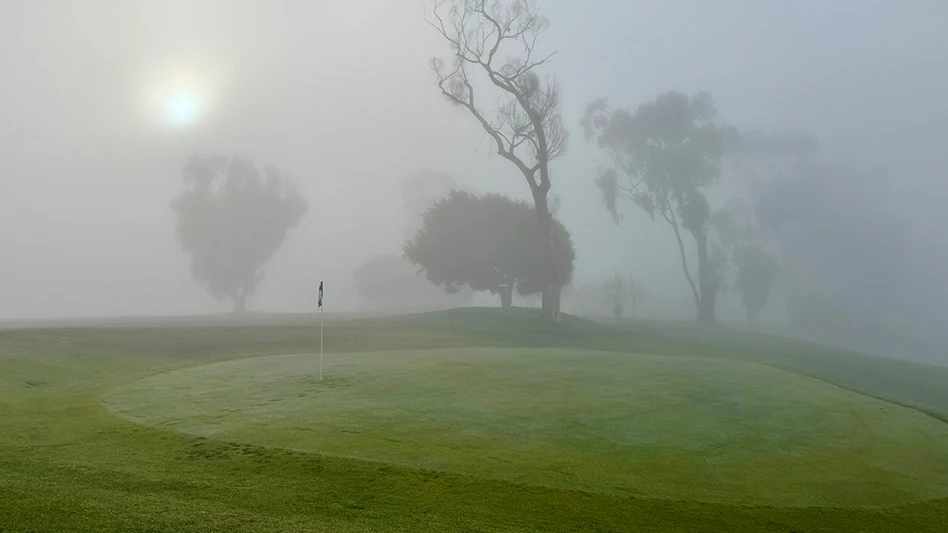
Kelly Shumate replicated more than 100 years of golf history using less than six acres while never losing sight of an obstacle his industry faces.
Shumate designed The Ashford Short Course at The Greenbrier, the enduring southern West Virginia resort where preservation drives decisions and guests have been playing golf since the early 1900s. He juggled creating a 9-hole course possessing throwback charm with the demands he experiences as the resort’s director of golf course maintenance.
Named in honor of Army physician Col. Bailey K. Ashford, the course opened in 2018. More than 25,000 soldiers were treated at Ashford General Hospital on the resort grounds from 1942 to 1946. The course measures less than 1,000 yards and meshes fashion and function.
Because this magazine serves golf course maintenance professionals, let’s start with function. Shumate’s primary job involves leading the maintenance efforts of the three 18-hole courses. The Old White and Meadows are open to all; the Snead Course is part of the private Greenbrier Sporting Club. Located across Sam Snead Drive from The Old White, the only Seth Raynor and C.B. Macdonald design open to the public, the Ashford occupies flat land beneath mountains and serves as an amenity for members and resort guests.
To keep this short course story, well, short, Shumate’s team must keep plenty of greenspace in grand condition. His background as a superintendent led him to designing a course under the premise that the golf labor supply is more likely to remain limited than be enlarged.
“I wanted to make sure I wasn’t creating something that was a maintenance nightmare,” Shumate says. “Even though golf has rebounded, we have had this labor shortage really going on for the last 20 years. I think any new course needs to take that into consideration. How can we build a course and have a bunch of interest without taking a whole load of people to maintain it? Those are the type of courses that will endure.”
The Greenbrier Sporting Club crew, led by superintendent Patrick Murphy, maintains The Ashford. On a normal day, play begins in the late morning and continues into the evening. Preparing the course often represents second-assignment jobs for Murphy’s crew.

Shumate incorporated just 13 bunkers into the layout. He calls the hazards “bathtub bunkers,” meaning they feature flat bottoms to prevent an abundance of washouts following heavy rain events. Bunker sizes range from 8 to 10 feet. One employee can hand rake the entire course in about an hour.
Greens, tees and approaches are A-1/A-4 bentgrass, the same variety used on the Snead. Shumate designed a pair of double greens and The Ashford features around 40,000 square feet of putting surfaces. Turf-type tall fescue surrounds and rough and fine fescue mounding complete the grassing lineup.
The horrific southern West Virginia floods of 2016 sparked a major restoration and reconfiguring of The Greenbrier’s golf offerings. Shumate’s rework of the Meadows course opened enough land on the former 11th and 12th holes for The Ashford and accompanying homesites. The start of the short course movement among resorts coincided with The Greenbrier’s post-flood land planning process.
A golf course architecture aficionado who constantly studies routings, satellite imagery and landforms, Shumate designed The Ashford as he guided a determined team through a heroic recovery that concluded with the resort hosting the PGA Tour’s Greenbrier Classic in 2017. Between tournament maintenance shifts in 2017, Shumate and a shaper started work on The Ashford. The course debuted in August 2018.
As for the fashion side of things, Shumate wanted to promote elements of what makes The Old White a Golden Age staple and resort guest favorite, including a few Raynor and Macdonald template greens. “Because that’s what The Greenbrier is known for,” he says. “A lot of people relate to that and ask: Did you play the redan? Did you play the biarritz? Did you play the punchbowl? Those things stick out. But I didn’t want to do a complete nine holes of that.”
The Ashford begins with a punchbowl green and boasts a redan (slopes from front corner to back corner) and reverse redan (slopes from back corner to front corner). The Ashford redans contrast the famed eighth hole of The Old White, because most golfers are hitting wedges instead of long irons into both greens. The holes feature clever Golden Age-themed names such as “Press,” “Duel,” and “Papa,” and none plays longer than 112 yards. The course can be walked in less than an hour.
“You have to create interest and you want people to come back,” Shumate says. “If you’re fishing, you want that perfect lure. You want something for them to bite on. People want to feel good about themselves and get excited and not feel beat up. That’s what I tried to do with The Ashford.”
Shumate’s interest in golf and, perhaps, golf course architecture stems from his parents dropping him off as a teenager at Twin Falls State Park, the only course near his hometown of Mullens, West Virginia. He played the course multiple times per day, carrying his bag around the hilly layout until one of his parents returned in the evening. Experiencing the same course repeatedly eventually provided little mental stimulation and Shumate made an innocent comment to the pro about his desire to play elsewhere. The pro suggested playing the course backward.
“I would start on 18, then play the 17th green, then start on 17 and play to 16th green,” Shumate says. “It was freaky because in the mountains of West Virginia nothing is connected. But it was really, really, interesting. I then started making my own holes. A busy day back then was maybe 25, 30 rounds, at that park. Not a lot of people were playing. Maybe that’s where I got started in golf course architecture.”
A few decades later, Shumate is designing holes for visitors exploring the beauty of his native region. Unlike his teenage years, he also must consider short- and long-term maintenance. “I feel blessed that ownership gave me the opportunity,” he says. “It’s something that I love and it’s something that I have an itch for. And short courses are something that’s good for the game.”

Explore the October 2020 Issue
Check out more from this issue and find your next story to read.
Latest from Golf Course Industry
- Beyond the Page 65: New faces on the back page
- From the publisher’s pen: New? No way!
- Indiana course upgrades range with synthetic ‘bunkers’
- Monterey Peninsula CC Shore Course renovation almost finished
- KemperSports and Touchstone Golf announce partnership
- PBI-Gordon Company hires marketing manager Jared Hoyle
- Mountain Sky Guest Ranch announces bunker enhancement project
- GCSAA names Joshua Tapp director of environmental programs





